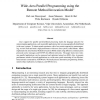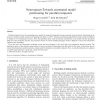1003 search results - page 89 / 201 » How to Parallelize Sequential Processes |
OSDI
1994
ACM
13 years 10 months ago
1994
ACM
Parallel processing has been proposed as a means of improving network protocol throughput. Several different strategies have been taken towards parallelizing protocols. A relative...
ICPPW
2008
IEEE
14 years 3 months ago
2008
IEEE
Event traces are helpful in understanding the performance behavior of message-passing applications since they allow in-depth analyses of communication and synchronization patterns...
CONCURRENCY
2000
13 years 8 months ago
2000
Java's support for parallel and distributed processing makes the language attractive for metacomputing applications, such as parallel applications that run on geographically ...
PC
2007
13 years 8 months ago
2007
Parallel volume rendering is one of the most efficient techniques to achieve real time visualization of large datasets by distributing the data and the rendering process over a c...
IJON
2007
13 years 8 months ago
2007
Parallel computers have the computing power needed to simulate biologically accurate neuronal network models. Partitioning is the process of cutting a model in pieces and assignin...



